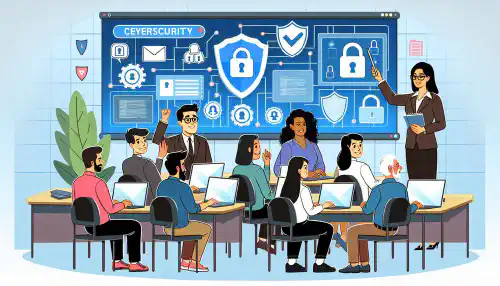Empower Your Workforce: Building a Resilient Human Firewall Against Cyber Threats

Table of Contents
Building a Human Firewall: Training Employees in Cybersecurity
In today’s digital age, cybersecurity has become a critical concern for organizations of all sizes. With the increasing frequency and sophistication of cyber attacks, it is essential for businesses to build a strong defense against potential threats. One of the key components of a robust cybersecurity strategy is training employees to become a human firewall. By equipping employees with the knowledge and skills to identify and respond to cyber threats, organizations can significantly reduce the risk of a security breach. This article explores the importance of cybersecurity training, provides insights into designing an effective training program, discusses strategies to engage employees in training, addresses challenges in training implementation, and highlights the methods to measure the impact of cybersecurity training.
Key Takeaways
- Cybersecurity training is crucial in today’s digital age to protect organizations from cyber attacks.
- Designing an effective cybersecurity training program involves identifying training needs, creating engaging materials, implementing simulated cyber attack scenarios, and measuring training effectiveness.
- Engaging employees in cybersecurity training requires building awareness, promoting a culture of responsibility, incentivizing participation, providing ongoing support, and encouraging reporting.
- Challenges in cybersecurity training include resistance to change, lack of awareness, time and resource constraints, tailoring training for different roles, and keeping up with evolving threats and technologies.
- Measuring the impact of cybersecurity training can be done through assessing knowledge acquisition, tracking behavioral changes, analyzing incident data, quantifying ROI, and benchmarking performance.
Understanding the Importance of Cybersecurity Training
The Growing Threat of Cyber Attacks
Cyber attacks have become an increasingly prevalent and sophisticated threat in today’s digital landscape. Organizations across industries are facing a constant barrage of attacks, ranging from phishing and malware to ransomware and data breaches. These attacks can have devastating consequences, including financial loss, reputational damage, and legal liabilities.
To illustrate the severity of the situation, consider the following statistics:
| Type of Attack | Frequency |
|---|---|
| Phishing | 1.5 million attempts per month |
| Malware | 350,000 new variants per day |
| Ransomware | $20 billion in damages in 2020 |
These numbers highlight the scale and impact of cyber attacks, emphasizing the urgent need for organizations to prioritize cybersecurity training for their employees. By equipping employees with the knowledge and skills to identify and respond to potential threats, organizations can significantly reduce the risk of successful cyber attacks.
- Cyber attacks are a prevalent and sophisticated threat in today’s digital landscape.
- Organizations face a constant barrage of attacks, including phishing, malware, ransomware, and data breaches.
- The consequences of cyber attacks can be devastating, including financial loss, reputational damage, and legal liabilities.
- Phishing attempts occur at a rate of 1.5 million per month, highlighting the scale of the problem.
- Malware continues to evolve, with 350,000 new variants being detected daily.
- Ransomware caused $20 billion in damages in 2020 alone.
- Prioritizing cybersecurity training for employees is crucial in mitigating the risk of successful cyber attacks.
The Role of Employees in Cybersecurity
Employees play a crucial role in maintaining the security of an organization’s digital assets. They are the first line of defense against cyber threats and their daily actions can have a significant impact on the overall security posture. It is important for employees to understand the potential risks and vulnerabilities that exist in the digital landscape and to be aware of the best practices and protocols for mitigating those risks. By following security policies and procedures, employees can help prevent security breaches and protect sensitive information.
Designing an Effective Cybersecurity Training Program

Identifying Training Needs and Objectives
To design an effective cybersecurity training program, it is crucial to first identify the specific training needs and objectives. This process involves assessing the current knowledge and skills of employees, as well as understanding the unique cybersecurity risks and challenges faced by the organization. Thorough assessment and analysis of the existing cybersecurity infrastructure and practices can help in identifying gaps and areas that require improvement.
Once the training needs have been identified, it is important to establish clear objectives for the training program. These objectives should align with the overall cybersecurity goals of the organization and address the specific areas of improvement identified. Objectives should be specific, measurable, achievable, relevant, and time-bound (SMART). This ensures that the training program is focused and provides tangible outcomes.
To summarize, the process of identifying training needs and objectives involves:
- Assessing the current knowledge and skills of employees
- Analyzing the existing cybersecurity infrastructure and practices
- Identifying gaps and areas that require improvement
- Establishing clear and specific objectives that align with overall cybersecurity goals
Tip: Regularly reassess the training needs and objectives to adapt to the evolving cybersecurity landscape and address emerging threats.
Creating Engaging and Interactive Training Materials
Creating engaging and interactive training materials is crucial for effective cybersecurity training. By using visual aids such as infographics and videos, employees can better understand complex concepts and retain information more effectively. Additionally, incorporating real-life examples and case studies can help employees relate to the material and see the relevance of cybersecurity in their daily work.
To further enhance engagement, interactive elements such as quizzes and scenarios can be included in the training materials. These interactive components allow employees to actively participate in the learning process and apply their knowledge to practical situations. Moreover, incorporating gamification elements, such as leaderboards and rewards, can create a sense of competition and motivation among employees.
To ensure the effectiveness of the training materials, it is important to consider the learning preferences of employees. Some individuals may prefer visual learning, while others may prefer auditory or kinesthetic learning. By providing a variety of content formats, such as written materials, videos, and hands-on exercises, the training program can cater to different learning styles.
In addition to the content itself, the delivery method of the training materials is also crucial. Online platforms and learning management systems can provide a convenient and accessible way for employees to access the training materials. Furthermore, regular updates and refreshers should be provided to ensure that the training materials remain up-to-date and relevant in the ever-evolving field of cybersecurity.
Implementing Simulated Cyber Attack Scenarios
Simulated cyber attack scenarios are a crucial component of an effective cybersecurity training program. By exposing employees to realistic cyber threats in a controlled environment, organizations can assess their readiness and identify areas for improvement. These scenarios simulate various types of attacks, such as phishing emails, malware infections, and social engineering techniques, to test employees’ ability to detect and respond to these threats.
Implementing simulated cyber attack scenarios involves several key steps:
Planning and Preparation: Before conducting the simulations, organizations need to define the objectives, scope, and desired outcomes of the scenarios. This includes identifying the specific attack techniques to be simulated and determining the level of difficulty.
Scenario Development: Once the objectives are established, organizations can create realistic scenarios that mimic real-world cyber attacks. This may involve designing phishing emails, creating malicious websites, or developing simulated malware.
Execution and Evaluation: During the simulations, employees are exposed to the simulated attacks, and their responses are monitored and evaluated. This allows organizations to assess their employees’ ability to recognize and respond to the threats effectively.
Debriefing and Learning: After the simulations, it is essential to provide feedback and guidance to employees. This includes discussing the outcomes of the scenarios, highlighting areas for improvement, and providing additional training resources.
Implementing simulated cyber attack scenarios not only helps organizations identify vulnerabilities but also raises employees’ awareness of the potential risks they face. By experiencing these simulated attacks, employees gain firsthand knowledge of the tactics used by cybercriminals and develop the skills needed to protect themselves and the organization.
Tip: To maximize the effectiveness of simulated cyber attack scenarios, organizations should ensure that the scenarios are regularly updated to reflect the latest threats and attack techniques.
Measuring the Effectiveness of Training
Effective measurement of cybersecurity training is crucial to assess its impact and make informed decisions for improvement. By evaluating various aspects of the training program, organizations can determine its effectiveness and identify areas for enhancement. Key metrics that can be used to measure the effectiveness of cybersecurity training include:
- Knowledge and Skills Acquisition: Assessing the extent to which employees have gained knowledge and developed the necessary skills to identify and respond to cyber threats.
- Behavioral Changes and Compliance: Tracking changes in employee behavior, such as adherence to security policies and procedures, and compliance with best practices.
- Incident and Breach Data Analysis: Analyzing incident and breach data to determine if there has been a reduction in security incidents and breaches as a result of the training.
- Return on Investment (ROI): Quantifying the financial impact of the training program by comparing the costs associated with the program to the benefits gained.
- Benchmarking and Comparing Performance: Comparing the performance of employees who have undergone training with those who have not, or with industry benchmarks, to evaluate the effectiveness of the program.
To effectively measure the impact of cybersecurity training, organizations should establish clear objectives, define relevant metrics, and implement appropriate evaluation methods. Regular assessments should be conducted to track progress and identify areas for improvement. By continuously monitoring and evaluating the effectiveness of training, organizations can ensure that their employees are well-equipped to defend against cyber threats.
Continuous Improvement and Adaptation
Continuous improvement and adaptation are crucial in cybersecurity training. As the latest threats and attack techniques evolve , it is important to stay updated and modify training programs accordingly. Here are some key strategies for continuous improvement and adaptation:
Engaging Employees in Cybersecurity Training

Building Awareness and a Security Mindset
Building awareness and fostering a security mindset among employees is crucial in creating a strong human firewall against cyber threats. By instilling a sense of responsibility and vigilance, organizations can empower their workforce to actively contribute to the protection of sensitive information and the prevention of security breaches.
Promoting a Culture of Responsibility
Promoting a culture of responsibility is crucial in building a strong cybersecurity posture within an organization. By instilling a sense of ownership and accountability among employees, organizations can create a collective effort towards maintaining security safeguards and protecting sensitive information. This can be achieved through the following strategies:
Incentivizing Employee Participation
Incentivizing employee participation is crucial for the success of a cybersecurity training program. By creating a culture of engagement and motivation, organizations can foster a resilient human firewall that actively contributes to the protection of sensitive data and systems.
Providing Ongoing Support and Resources
As a cybersecurity expert, it is crucial to provide ongoing support and resources to employees to ensure their knowledge and skills remain up to date. This support can help them stay vigilant and proactive in identifying and mitigating potential cyber threats. Here are some key strategies for providing ongoing support and resources:
Regular Training Updates: Conduct regular training sessions to update employees on the latest cybersecurity threats, trends, and best practices. This will help them stay informed and adapt their security practices accordingly.
Access to Knowledge Base: Establish a centralized knowledge base or resource library where employees can access relevant cybersecurity information, guidelines, and resources. This will enable them to find answers to their questions and stay informed about emerging threats.
Cybersecurity Awareness Campaigns: Launch awareness campaigns to reinforce the importance of cybersecurity and promote a culture of security within the organization. These campaigns can include posters, email reminders, and interactive activities to engage employees.
Tip: Encourage employees to share their cybersecurity experiences and lessons learned to foster a collaborative learning environment.
Regular Communication: Maintain open lines of communication with employees regarding cybersecurity updates, policy changes, and incident reporting procedures. This will ensure that employees are aware of any changes and can promptly report any suspicious activities or incidents.
Supportive IT Helpdesk: Provide a dedicated IT helpdesk or support team that can assist employees with cybersecurity-related queries, troubleshooting, and incident response. This will give employees a reliable resource to turn to when they encounter security issues.
Reward and Recognition: Recognize and reward employees who actively participate in cybersecurity training and demonstrate good security practices. This can be done through incentives, certificates, or public recognition to motivate employees to prioritize cybersecurity.
Continuous Improvement: Regularly evaluate the effectiveness of the cybersecurity training program and gather feedback from employees. Use this feedback to make necessary improvements and adapt the training program to address emerging threats and evolving employee needs.
By implementing these strategies, organizations can ensure that employees have the ongoing support and resources they need to effectively contribute to the organization’s cybersecurity efforts.
Encouraging Reporting and Incident Response
Encouraging employees to report security incidents and respond effectively is crucial for maintaining a strong cybersecurity posture. By fostering a culture of transparency and accountability, organizations can empower their employees to play an active role in protecting sensitive information and mitigating potential threats.
To encourage reporting and incident response, organizations can:
- Provide clear guidelines and procedures for reporting security incidents, ensuring that employees understand the steps to take when they encounter a potential threat.
- Offer anonymous reporting channels to alleviate concerns about retaliation or judgment, allowing employees to report incidents without fear of negative consequences.
- Recognize and reward employees who demonstrate proactive incident reporting and effective response, reinforcing the importance of their contributions to the organization’s security.
- Regularly communicate the impact of incident reporting and response on the organization’s overall cybersecurity posture, emphasizing the positive outcomes and the value of employee participation.
By implementing these strategies, organizations can create an environment where employees feel empowered to report incidents promptly and take appropriate actions to mitigate potential risks. This proactive approach strengthens the organization’s ability to detect and respond to security incidents, minimizing the potential impact of cyber threats.
Overcoming Challenges in Cybersecurity Training

Resistance to Change and Lack of Awareness
Resistance to change and lack of awareness are common challenges faced when implementing cybersecurity training programs. Employees may be resistant to change due to a fear of the unknown or a belief that cybersecurity is solely the responsibility of the IT department. Additionally, many employees may not fully understand the potential consequences of a security breach or the role they play in preventing such incidents.
To address these challenges, organizations can take several steps:
Education and Communication: Providing clear and concise information about the importance of cybersecurity and the potential risks can help employees understand the need for training. Regular communication and updates can also help create awareness and keep cybersecurity top of mind.
Engagement and Involvement: Involving employees in the design and development of the training program can increase their buy-in and motivation to participate. Engaging employees through interactive and hands-on activities can also make the training more effective and enjoyable.
Leadership Support: Leadership support is crucial in overcoming resistance to change. When leaders actively promote and participate in cybersecurity training, it sends a strong message to employees about the importance of the program.
Incentives and Rewards: Offering incentives and rewards for completing training modules or demonstrating good cybersecurity practices can help motivate employees to actively participate in the training program.
Continuous Reinforcement: Cybersecurity training should not be a one-time event. It should be an ongoing process with regular refreshers and updates to keep employees informed about new threats and best practices.
By addressing resistance to change and lack of awareness, organizations can build a strong human firewall and empower employees to be the first line of defense against cyber threats.
Addressing Time and Resource Constraints
In the fast-paced world of cybersecurity, time and resources are often limited. However, it is crucial to prioritize training efforts to ensure the security of an organization. Efficient allocation of time and resources can help address these constraints and maximize the impact of cybersecurity training. Here are some strategies to consider:
Tailoring Training for Different Roles and Levels
Tailoring cybersecurity training to the specific roles and levels within an organization is crucial for ensuring its effectiveness. Each role may have different responsibilities and access levels, which require different knowledge and skills to mitigate cyber threats. Customizing the training content and delivery methods based on these differences can help employees understand the relevance of cybersecurity to their specific job functions.
To tailor training for different roles and levels, organizations can consider the following approaches:
Role-based training: Identify the specific cybersecurity knowledge and skills required for each role and develop training materials that address those needs. This can include understanding the types of threats relevant to the role, best practices for secure data handling, and incident response procedures.
Level-based training: Recognize that employees at different levels within the organization may have varying degrees of cybersecurity awareness and expertise. Provide training that is appropriate for their level of knowledge and experience, ensuring that it builds upon their existing understanding.
Job-specific scenarios: Incorporate job-specific scenarios and examples into the training to make it more relatable and applicable to employees’ daily tasks. This can help them understand how cybersecurity practices directly impact their work and the potential consequences of not following security protocols.
Continuous learning: Cybersecurity threats and technologies are constantly evolving, so it’s important to provide ongoing training and resources to keep employees up to date. This can include regular refresher courses, access to relevant articles and resources, and encouraging participation in industry conferences and webinars.
Tailoring cybersecurity training for different roles and levels helps ensure that employees receive the knowledge and skills necessary to effectively protect the organization from cyber threats. By customizing the training to their specific job functions, employees can better understand the importance of cybersecurity and their role in maintaining a secure environment.
Dealing with Employee Turnover and Onboarding
Employee turnover and onboarding present unique challenges in cybersecurity training. As new employees join the organization, it is crucial to ensure they receive the necessary training to understand their role in maintaining cybersecurity. Here are some key considerations when dealing with employee turnover and onboarding:
Develop a comprehensive onboarding program that includes cybersecurity training as a core component. This program should cover the basics of cybersecurity, such as password management, data protection, and recognizing phishing attempts.
Assign a dedicated cybersecurity mentor or buddy to new employees. This mentor can provide guidance and support, answer questions, and help new employees navigate the organization’s cybersecurity policies and procedures.
Conduct regular cybersecurity refresher training sessions for all employees, including those who have recently joined the organization. This ensures that everyone is up to date with the latest threats, best practices, and organizational policies.
Implement a knowledge transfer process for departing employees. When an employee leaves the organization, their knowledge and expertise in cybersecurity should be captured and shared with the remaining team members. This helps to minimize the impact of employee turnover on the organization’s cybersecurity posture.
Continuously evaluate and improve the onboarding and training program based on feedback from new employees and the cybersecurity team. This feedback can help identify areas for improvement and ensure that the training program remains effective and relevant.
Foster a culture of cybersecurity awareness and responsibility throughout the organization. Encourage all employees, both new and existing, to actively participate in maintaining a strong cybersecurity posture. This can be achieved through regular communication, awareness campaigns, and recognition of employees who demonstrate exemplary cybersecurity practices.
Tip: It is important to integrate cybersecurity training into the onboarding process to ensure that new employees are equipped with the knowledge and skills necessary to protect the organization from cyber threats.
Keeping Up with Evolving Threats and Technologies
As a cybersecurity expert, it is crucial to stay updated with the ever-evolving landscape of threats and technologies. The rapid advancements in technology and the increasing sophistication of cyber attacks require constant vigilance and proactive measures. Here are some key strategies to help organizations keep up with these challenges:
Continuous Learning and Training: Regularly invest in training programs and workshops to ensure employees are equipped with the latest knowledge and skills. This includes staying informed about emerging threats, new attack vectors, and evolving technologies.
Engage with Industry Communities: Participate in cybersecurity conferences, forums, and online communities to network with peers, share insights, and learn from industry experts. These platforms provide opportunities to discuss emerging trends, best practices, and innovative solutions.
Threat Intelligence Sharing: Collaborate with other organizations, industry groups, and government agencies to share threat intelligence. By pooling resources and sharing information about new threats and attack techniques, organizations can collectively strengthen their defenses.
Adopting a Risk-Based Approach: Prioritize cybersecurity efforts based on risk assessments and threat intelligence. This involves identifying critical assets, evaluating potential vulnerabilities, and implementing appropriate security controls to mitigate risks.
Tip: Regularly review and update your organization’s cybersecurity policies and procedures to align with the latest industry standards and best practices.
Invest in Advanced Technologies: Leverage cutting-edge cybersecurity technologies, such as artificial intelligence (AI), machine learning (ML), and behavioral analytics, to detect and respond to emerging threats in real-time.
Stay Informed about Regulatory Changes: Keep abreast of regulatory changes and compliance requirements related to cybersecurity. This includes understanding the implications of new laws and regulations, such as data protection and privacy laws, and ensuring organizational practices align with these requirements.
Engage in Red Teaming and Penetration Testing: Regularly conduct red teaming exercises and penetration testing to identify vulnerabilities in your organization’s systems and processes. This proactive approach helps uncover weaknesses before they can be exploited by attackers.
By following these strategies, organizations can enhance their cybersecurity posture and effectively mitigate the risks posed by evolving threats and technologies.
Measuring the Impact of Cybersecurity Training

Assessing Knowledge and Skills Acquisition
Assessing the knowledge and skills acquired by employees through cybersecurity training is crucial in evaluating the effectiveness of the program. By measuring the level of understanding and proficiency, organizations can identify areas of improvement and tailor future training initiatives accordingly.
To assess knowledge and skills acquisition, organizations can employ various methods, including:
Written Assessments: Conducting written assessments can gauge employees’ understanding of cybersecurity concepts, best practices, and protocols. These assessments can be in the form of multiple-choice questions, short answer questions, or scenario-based exercises.
Practical Exercises: Implementing practical exercises allows employees to apply their knowledge in simulated cybersecurity scenarios. These exercises can involve identifying and responding to potential threats, analyzing suspicious emails, or detecting vulnerabilities in a system.
Simulated Attacks: Simulated cyber attacks can test employees’ ability to recognize and respond to real-world threats. These exercises can simulate phishing attempts, malware infections, or social engineering tactics to assess employees’ awareness and response capabilities.
Observation and Feedback: Observing employees’ behavior and soliciting feedback from supervisors and colleagues can provide valuable insights into their application of cybersecurity knowledge and skills in their day-to-day activities.
Performance Metrics: Tracking performance metrics, such as the number of reported incidents, successful phishing simulations, or completion of security awareness training modules, can help measure the effectiveness of cybersecurity training.
It is important for organizations to regularly evaluate and update their assessment methods to align with evolving cybersecurity threats and technologies. By continuously assessing knowledge and skills acquisition, organizations can ensure that their employees are equipped with the necessary capabilities to defend against cyber attacks.
Tracking Behavioral Changes and Compliance
Tracking behavioral changes and compliance is a crucial aspect of measuring the effectiveness of cybersecurity training. By monitoring employee behavior and ensuring compliance with security protocols, organizations can assess the impact of their training programs and identify areas for improvement.
To track behavioral changes and compliance, organizations can utilize various methods and tools. One effective approach is to conduct regular assessments and evaluations to gauge employees’ knowledge and understanding of cybersecurity best practices. These assessments can include quizzes, simulations, and practical exercises that test employees’ ability to identify and respond to potential security threats.
Another method is to monitor employee adherence to security policies and procedures. This can be done through the use of security incident reports, access logs, and system audits. By analyzing this data, organizations can identify any patterns of non-compliance or areas where additional training may be needed.
In addition to these methods, organizations can also leverage technology to track behavioral changes and compliance. This can involve the use of security awareness training platforms that provide real-time feedback and analytics on employee engagement and progress. These platforms can track metrics such as completion rates, quiz scores, and participation in simulated cyber attack scenarios.
By tracking behavioral changes and compliance, organizations can gain valuable insights into the effectiveness of their cybersecurity training programs. This data can be used to make informed decisions about training content, delivery methods, and ongoing support. It also allows organizations to demonstrate the return on investment (ROI) of their training initiatives and ensure that employees are equipped with the knowledge and skills to protect against cyber threats.
Analyzing Incident and Breach Data
Analyzing incident and breach data is a crucial step in evaluating the effectiveness of cybersecurity training programs. By examining the data, organizations can gain valuable insights into the types of incidents and breaches that occur, the vulnerabilities that are exploited, and the impact on the business. This analysis helps identify areas of improvement and informs future training initiatives.
To effectively analyze incident and breach data, organizations can utilize data visualization techniques to present the information in a clear and concise manner. Visual representations such as charts, graphs, and heatmaps can help identify patterns, trends, and outliers. These visualizations enable cybersecurity experts to make informed decisions and prioritize areas for remediation.
In addition to data visualization, organizations should also consider implementing incident response metrics to measure the effectiveness of their training programs. These metrics can include the average time to detect and respond to incidents, the number of incidents successfully mitigated, and the percentage of incidents caused by human error. By tracking these metrics over time, organizations can assess the impact of training on incident response capabilities.
To further enhance the analysis of incident and breach data, organizations can leverage machine learning algorithms. These algorithms can identify patterns and anomalies in large datasets, enabling organizations to detect and respond to potential threats more effectively. Machine learning can also help automate the analysis process, saving time and resources.
In summary, analyzing incident and breach data is essential for evaluating the effectiveness of cybersecurity training programs. By utilizing data visualization techniques, incident response metrics, and machine learning algorithms, organizations can gain valuable insights and improve their overall cybersecurity posture.
Quantifying Return on Investment (ROI)
Quantifying the return on investment (ROI) of cybersecurity training is crucial for organizations to assess the effectiveness of their training programs. ROI provides a quantitative measure of the benefits gained from the investment in training, helping organizations justify the allocation of resources and make informed decisions. It allows organizations to evaluate the impact of cybersecurity training on various aspects, such as reducing the number of security incidents, minimizing the financial losses associated with breaches, and enhancing the overall security posture.
To quantify the ROI of cybersecurity training, organizations can consider the following approaches:
Benchmarking and Comparing Performance
Benchmarking and comparing performance is a crucial step in evaluating the effectiveness of cybersecurity training programs . By measuring and analyzing the outcomes of the training, organizations can identify areas of improvement and make informed decisions for future training initiatives. This process involves assessing various metrics and indicators to gauge the impact of the training on employees’ knowledge, skills, and behavior. It also allows organizations to benchmark their performance against industry standards and best practices, providing valuable insights into their cybersecurity posture.
Measuring the Impact of Cyber security Training
Conclusion
In conclusion, cybersecurity training for employees is of utmost importance in today’s digital landscape. The growing threat of cyber attacks highlights the need for organizations to invest in training programs that equip their employees with the necessary knowledge and skills to protect sensitive information. Employees play a crucial role in cybersecurity, as they are often the first line of defense against potential threats. The consequences of a security breach can be severe, including financial loss, damage to reputation, and legal implications.
Designing an effective cybersecurity training program involves identifying the specific training needs and objectives of the organization, creating engaging and interactive training materials, implementing simulated cyber attack scenarios, and continuously measuring the effectiveness of the training. Engaging employees in cybersecurity training requires building awareness and a security mindset, promoting a culture of responsibility, incentivizing employee participation, providing ongoing support and resources, and encouraging reporting and incident response.
However, there are challenges that organizations may face in implementing cybersecurity training. Resistance to change and lack of awareness among employees can hinder the success of training programs. Addressing time and resource constraints is crucial to ensure that employees have sufficient time and resources to participate in training activities. Tailoring training for different roles and levels within the organization is essential to meet the specific needs of employees. Employee turnover and onboarding also pose challenges, as new employees need to be trained and existing employees need to be kept up to date with evolving threats and technologies.
Measuring the impact of cybersecurity training is vital to assess the effectiveness of the program. This can be done through assessing knowledge and skills acquisition, tracking behavioral changes and compliance, analyzing incident and breach data, quantifying return on investment (ROI), and benchmarking and comparing performance. By evaluating the impact of training, organizations can identify areas for improvement and make necessary adjustments to enhance their cybersecurity posture.
In conclusion, building a human firewall through cybersecurity training is a critical step in safeguarding organizations from cyber threats. By investing in comprehensive training programs and engaging employees in the process, organizations can create a culture of security and resilience. With the ever-evolving nature of cyber threats, continuous improvement and adaptation are key to staying ahead of potential risks. By prioritizing cybersecurity training, organizations can mitigate the risk of security breaches and protect their valuable assets.
Frequently Asked Questions
What is the importance of cybersecurity training?
Cybersecurity training is important because it helps employees understand the threats and risks associated with cyber attacks, and equips them with the knowledge and skills to protect themselves and the organization from potential breaches.
How can employees contribute to cybersecurity?
Employees play a crucial role in cybersecurity by following best practices, such as using strong passwords, being cautious of phishing emails, and reporting any suspicious activities. Their actions can help prevent security breaches and protect sensitive information.
What are the consequences of a security breach?
A security breach can have severe consequences, including financial losses, damage to the organization’s reputation, legal liabilities, and loss of customer trust. It can also lead to data theft, unauthorized access to systems, and disruption of business operations.
How can training materials be made engaging and interactive?
Training materials can be made engaging and interactive by incorporating multimedia elements, such as videos and interactive quizzes. Gamification techniques, such as rewards and challenges, can also be used to motivate employees and enhance their learning experience.
Why is measuring the effectiveness of training important?
Measuring the effectiveness of training helps organizations assess the impact of their cybersecurity programs and identify areas for improvement. It allows them to evaluate whether employees have acquired the necessary knowledge and skills to mitigate cyber risks effectively.
How can cybersecurity training be tailored for different roles and levels?
Cybersecurity training can be tailored for different roles and levels by customizing the content to address specific job responsibilities and skill requirements. Training programs can be designed to cater to different proficiency levels, from basic awareness training to advanced technical skills development.






